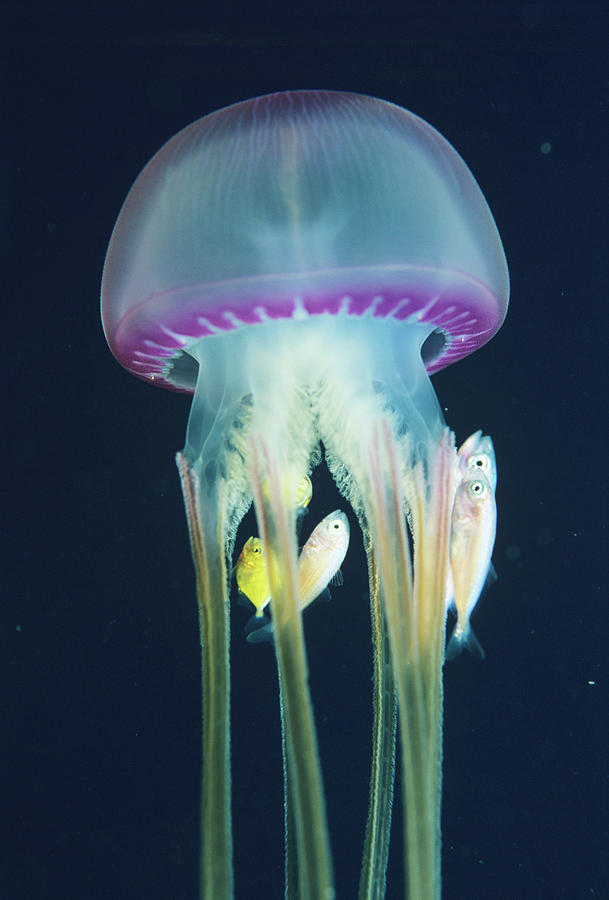Fish in a jellyfish
Living Fish Found Inside Jellyfish in Bizarre Underwater Scene
This startling image was made in December in Byron Bay, Australia.
Photograph by Tim Samuel
Please be respectful of copyright. Unauthorized use is prohibited.
Are you trudging through life slowly? Well, this fish—found inside a jellyfish—can sympathize with you.
Back in December, ocean photographers Tim Samuel and Franny Plumridge were freediving in Byron Bay, off the east coast of Australia, when Samuel spotted a curious scene. He made a picture of a yellow fish stuck inside a translucent jellyfish and posted it to his Instagram account.
It wasn’t until DiscoverOcean republished the picture on Tuesday that the image went viral. Samuel says he later posted the picture to Reddit, where it made the trending list—twice.
“Woke up this morning to my phone going crazy due to one [of] my photos being reposted,” Samuel wrote on Instagram. “It is crazy how much attention this little guy is getting. ”
Another view of the odd couple.
Photograph by Tim Samuel
Please be respectful of copyright. Unauthorized use is prohibited.
In his years of photographing marine life, Samuel hadn’t seen a similar scene before. The fish’s tail was sticking outside the back of the jelly, so it was able to propel the creature forward. Over the 20 minutes that Samuel and Plumridge watched in curiosity and amazement, the fish/jellyfish wobbled and swam in circles. The fish knocked the jelly off balance and pushed it from side to side in the water. At some points, the duo just stopped moving.
“I’d never seen anything like it before,” Samuel says.
After taking in the scene, Samuel and Plumridge left to photograph turtles.
"I definitely thought about setting it free,” Samuel told CNN, “but in the end decided to just let nature run its course."
So What is Going On?
While that fish is probably still wondering how it got inside that jellyfish, researchers are questioning the species of both these animals.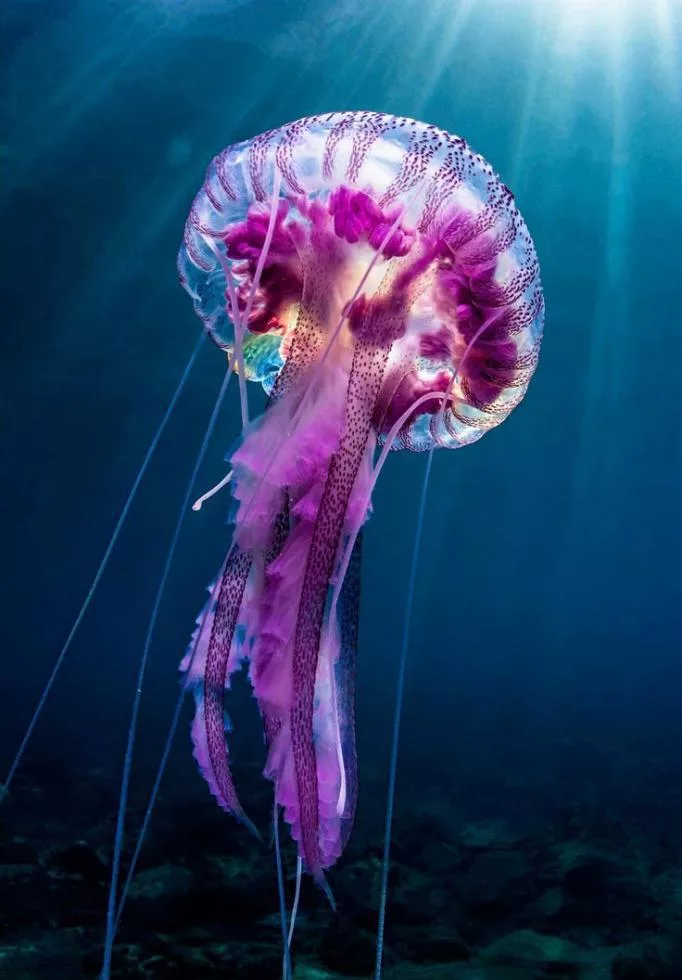
Rob Condon, an assistant professor at the University of North Carolina Wilmington, which houses the Jellyfish Database Initiative, says the jelly might be a hydromedusa. He says many types of animals associate with jellies, but he’s uncertain about the exact species of the fish.
“The importance of these types of associations are poorly understood but jellies are likely providing key ecosystem services that benefit the fish species in this regard,” Condon writes in an email.
Lisa-Ann Gershwin, a jellyfish taxonomist who has discovered about 200 species of jellyfish, is also questioning the jelly’s species.
Gershwin says the jellyfish looks like a chimera of two different classes, Cubozoa and Scyphozoa. But the number and look of the animal’s tentacles, as well as its shape, don’t add up to either class.
“Something really strange is going on there,” Gershwin says.
The unidentified fish has probably been inside the jellyfish for a while, Gershwin says, which would have deteriorated the jellyfish. But if the jelly had deteriorated, it wouldn’t have any tentacles left.
But if the jelly had deteriorated, it wouldn’t have any tentacles left.
Gershwin adds that it’s “totally normal” for fish to use jellies for feeding, protection, and locomotion. She’s just perplexed about both the animals and the photo.
This story was updated on July 8 at 5:30 pm ET with more info about the animals.
Read This Next
Subscriber Exclusive Content
Why are people so dang obsessed with Mars?
How viruses shape our world
The era of greyhound racing in the U.S. is coming to an end
See how people have imagined life on Mars through history
See how NASA’s new Mars rover will explore the red planet
Why are people so dang obsessed with Mars?
How viruses shape our world
The era of greyhound racing in the U.S. is coming to an end
See how people have imagined life on Mars through history
See how NASA’s new Mars rover will explore the red planet
Why are people so dang obsessed with Mars?
How viruses shape our world
The era of greyhound racing in the U.
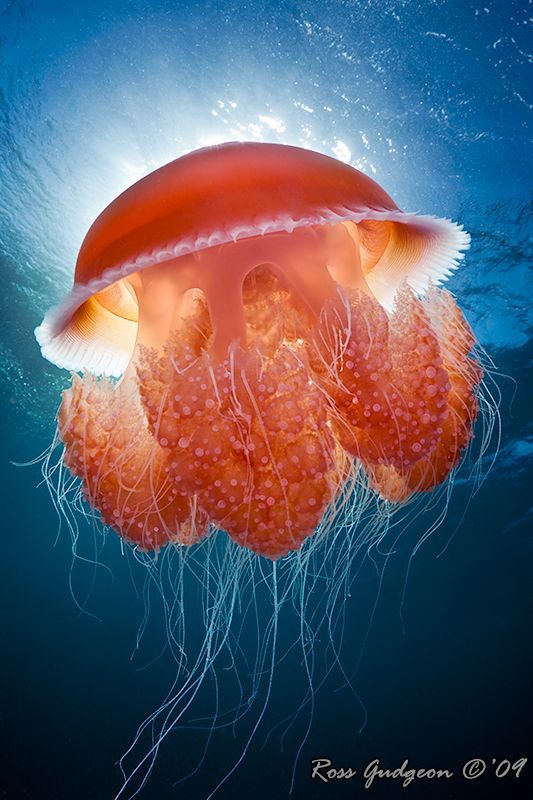 S. is coming to an end
S. is coming to an endSee how people have imagined life on Mars through history
See how NASA’s new Mars rover will explore the red planet
See More
Images of fish trapped inside a jellyfish don't tell the whole story
Photos of a fish swimming inside a jellyfish may tell an amazing story, but it's a story that likely didn't end well for at least one of the two animals, scientists say.
Australian photographer Tim Samuel captured the photos while freediving in Byron Bay, New South Wales, in December with his friend Franny Plumridge, who is in the background of one of the photos posted to Instagram.
They feature a yellow fish whose body occupies almost the entire bell of a transparent jellyfish with purple tentacles. Its tail protrudes outside the bell, allowing it to "drive" the jellyfish around.
"I found a fish inside a jellyfish!" Samuel wrote in the caption. "He was trapped in there, but controlled where the jellyfish was moving.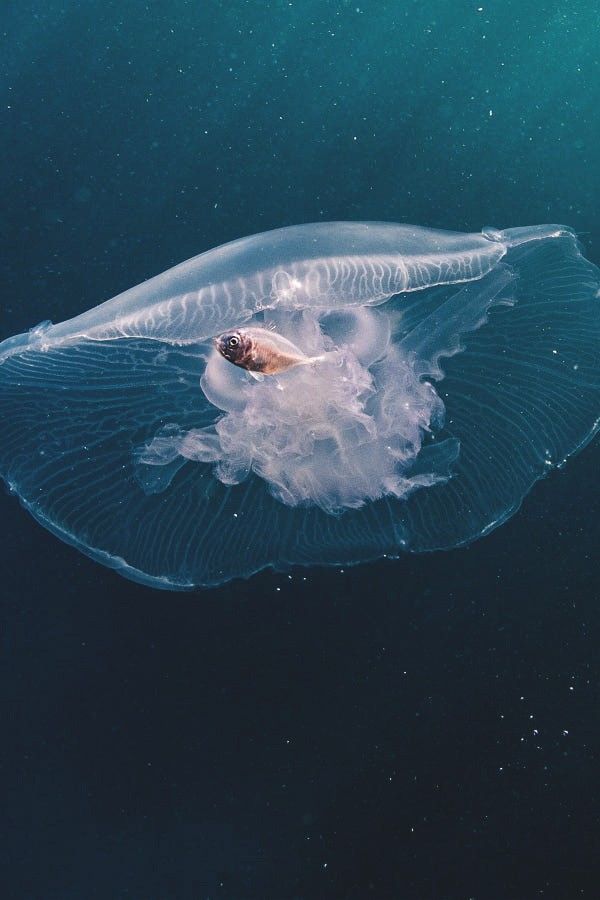 "
"
It's probably not going to end well for the jelly. - Danny Kent, Vancouver Aquarium
Samuel told CBC News in an email that the bell of the jellyfish was about six centimetres long and he photographed the pair near the surface for about 20 minutes before heading off in search of sea turtles.
CBC News sent the photos to a number of jellyfish researchers, including Lucas Brotz, a PhD student at the University of British Columbia, Michael Kinsgford, a professor at James Cook University in Australia, Luciano Chiaverano, a post-doctoral researcher at the University of Southern Mississippi, and Danny Kent, curator of B.C. waters at the Vancouver Aquarium.
All were impressed with the photos, which Brotz described as "pretty cool!" The researchers had never seen anything like them.
Kent said several jellyfish experts he consulted couldn't identify the jellyfish. Kingsford thought it was "definitely" not a box jellyfish, and suggested it could be a juvenile "scyphozoan" or "true jellyfish," the group that includes most familiar jellyfish such as moon jellyfish.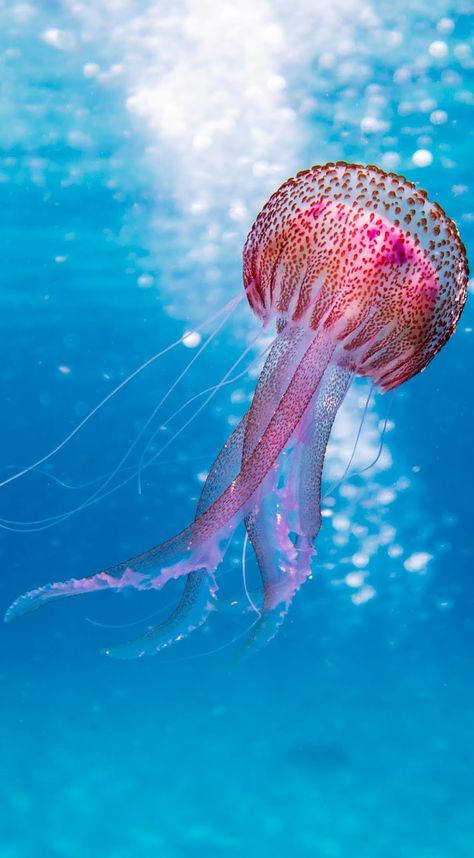
Brotz and Chiaverano weren't sure what kind of jellyfish it was, although they thought it was likely a box jellyfish.
Box jellyfish are highly venomous and prey on fish.
"They evolve to kill prey instantly," Chiaverano said. "This might be a case where the prey is too big to kill it right away, so the fish might have some time to swim around inside."
The fish does appear to be inside the jellyfish's stomach, he said.
But normally, box jellyfish eat prey that are only about a third or quarter the size of their bell, he added.
"That's one of the reasons why I think this is weird," he said. "I think it could have been an accident."
Kent said it didn't appear that the fish was affected much by jellyfish venom. He has another theory.
He thinks the fish looks like a type of jack or trevally — a group of fish that often hide under the bells of jellyfish when they are young.
Of course, normally they hide under jellyfish that are much larger than they are, he said.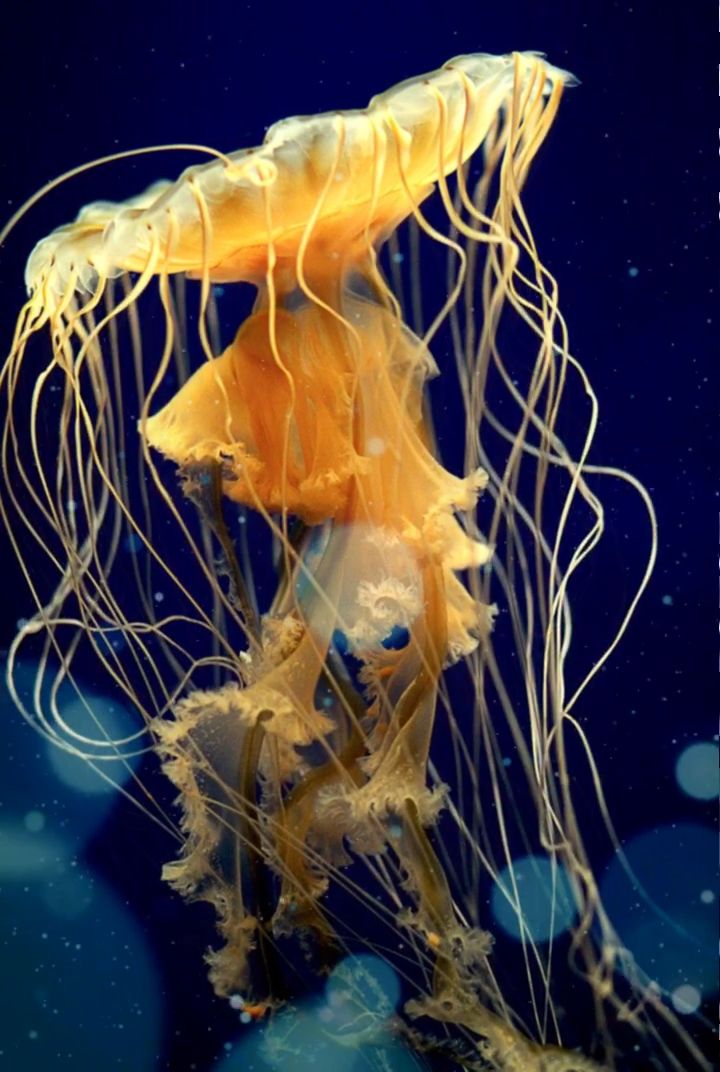
He, too, thought the encounter was likely an accident: "Accidents happen in nature as much as they do for us."
One of the photos shows what looks like an opening near the front of the bell, Chiaverano noted. That's not typical of a box jellyfish and is likely an injury from the fish trying to get out.
Kent agreed.
"It's probably not going to end well for the jelly," he said.
Chiaverano was even more pessimistic. He thought both creatures would likely end up dead, with the fish succumbing to the venom eventually and the jellyfish unable to digest it.
But he also suggested one less morbid possibility — that the photo could be fake.
Why jellyfish crowd out fish
At first glance, jellyfish as predators cannot compete with fish. Fish move actively and quickly, they can see their prey and pursue it; all this is inaccessible to jellyfish. Nevertheless, in some places in the World Ocean, a paradoxical picture is observed: jellyfish are replacing plankton-eating fish.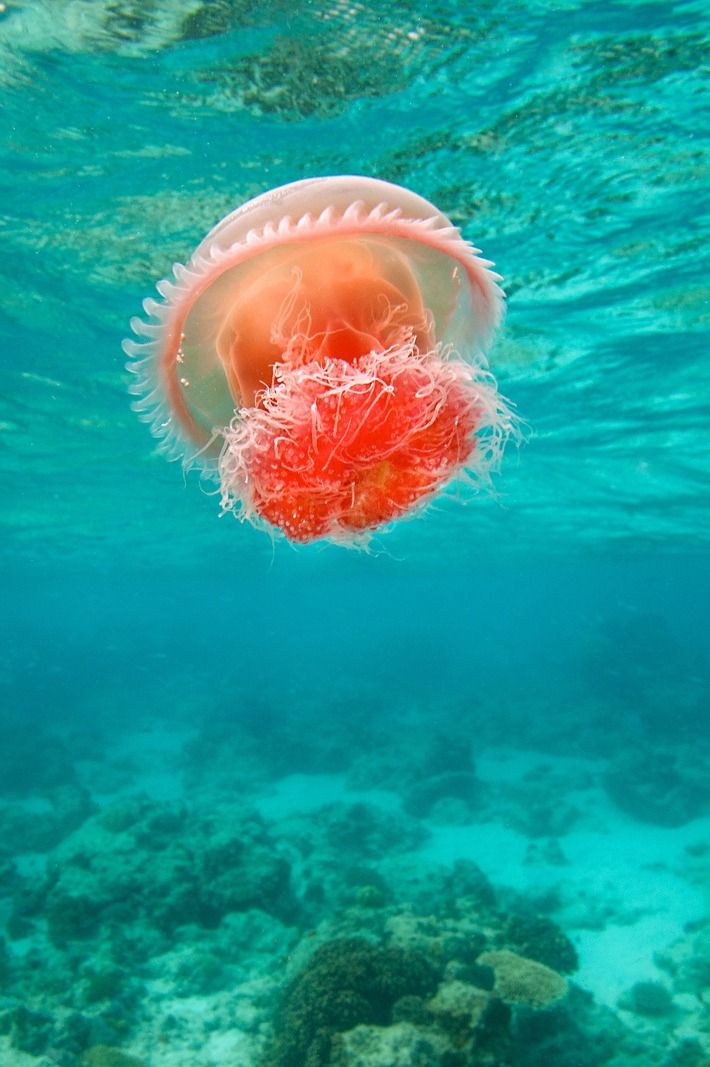 An international group of zoologists, having evaluated the advantages and disadvantages of jellyfish using a mathematical model, came to the conclusion that we still underestimate them.
An international group of zoologists, having evaluated the advantages and disadvantages of jellyfish using a mathematical model, came to the conclusion that we still underestimate them.
For the study, data were collected on more than 600 species of fish and jellyfish; scientists took into account such parameters as the efficiency of energy metabolism, speed, body size, etc. As a result, it turned out that the speed and agility of fish in terms of their efficiency do not give such a strong advantage over the type of organization of jellyfish. The latter really swim slowly, but at the same time they spend little energy, and their undeveloped eyesight allows them to ignore the visibility of their prey. Jellyfish can hunt even in the dark, which is inaccessible to fish that rely on sight.
The huge body of jellyfish, in fact, is a shaky gelatinous mass of organic substances, highly diluted with water. 96% of the water contained in the body, and stinging cells make jellyfish not too tempting prey for other predators.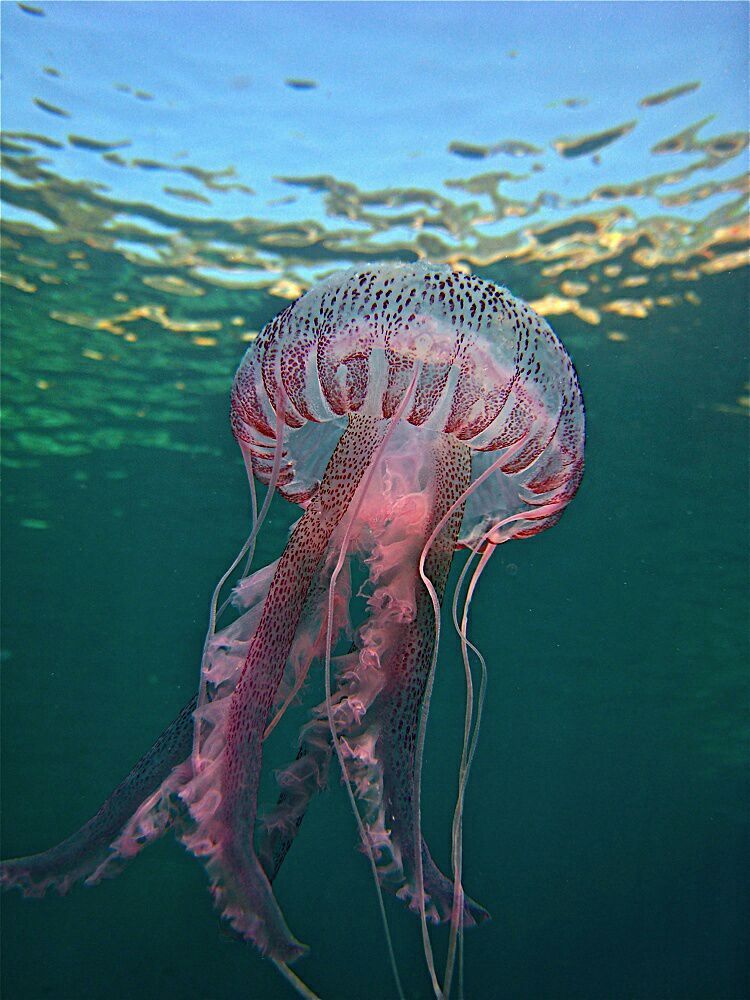 And a small amount of organic matter requires not so much effort when compared with fish. Finally, the impressive size of the body allows you to cover a large area, and the pulsating movements help pump water through the network of tentacles. Active hunting and bustle of the jellyfish preferred, so to speak, direct contact with the victim and increased their size. An article by researchers with the results of the work was published in the journal Science.
And a small amount of organic matter requires not so much effort when compared with fish. Finally, the impressive size of the body allows you to cover a large area, and the pulsating movements help pump water through the network of tentacles. Active hunting and bustle of the jellyfish preferred, so to speak, direct contact with the victim and increased their size. An article by researchers with the results of the work was published in the journal Science.
By themselves, jellyfish are not able to prevail over fish, but they can take the place of fish where the position of the latter has been shaken. The impoverishment of fish populations due to intensive fishing off the coast of Japan, in the northeastern United States, in the Black and Mediterranean Seas has shifted the balance towards jellyfish. These jelly-like predators do nothing to dislodge, for example, anchovies or sardines from the ocean. Therefore, as the authors of the article emphasize, a person should be especially careful with the biological balance in the ocean: jellyfish follow our every step and will not miss the chance to leave the sea without fish.
Source: science.compulenta.ru
| Your name * | |
| Contact e-mail (will not be shown) | |
| Comment * | |
| Is twice two equal? Enter the answer as ! | |
| By clicking the "Leave a comment" button, I confirm my legal capacity and consent to the processing of my personal data in accordance with the data privacy information. | |
Fields marked with * are mandatory.
All news
Jellyfish destroy fish and scare tourists off the coast of Britain
MOSCOW, August 19 - RIA Novosti. Hordes of jellyfish, which are becoming more and more numerous off the coast of Britain, threaten fishing and fish farms, as well as tourists who can suffer from burns, writes the British newspaper Independent.
Hordes of jellyfish, which are becoming more and more numerous off the coast of Britain, threaten fishing and fish farms, as well as tourists who can suffer from burns, writes the British newspaper Independent.
"This is a serious threat. Maybe in 20 years we will be ordering jellyfish and potatoes instead of traditional fish and chips," said Swansea University professor Graeme Hays.
Jellyfish are the least known of marine life, but they are causing increasing damage to tourism, aquaculture and fisheries, and their numbers are rapidly increasing.
Numerous cases of burns among swimmers in the Mediterranean, as well as significant damage to fisheries from the shores of the Black Sea to the South Atlantic, prompted joint research by scientists from the universities of Swansea and Cork.
According to the newspaper, British and Irish scientists led by Hayes have launched a large-scale Ecojel project, which plans to use the latest technological innovations, in particular, scientists will mark jellyfish in order to monitor their life cycle and their movements.
Experts hope to test the theory that overfishing may be one of the reasons for the increase in the number of jellyfish. Jellyfish and fish fry feed on the same plankton, and if one part is reduced, then the second, respectively, increases.
"We know very little about jellyfish, despite the fact that their population growth may be driven by overfishing and climate change, and this could have significant social and economic impacts," Hayes said.
Last November, Northern Ireland's only salmon farm was attacked by jellyfish, killing over 100,000 fish. Millions of small jellyfish known as "lilac stingers" have approached the cages, located a kilometer from the coast in the Irish Sea near Glenarm Bay and Cashendan.
Then jellyfish covered a surface of about 16 square kilometers and a depth of about ten meters, and although the rescuers tried to save the cages, this was not possible, because there were too many fish. The farm's CEO, John Russell, said he had never seen anything like it in his 30 years of operation.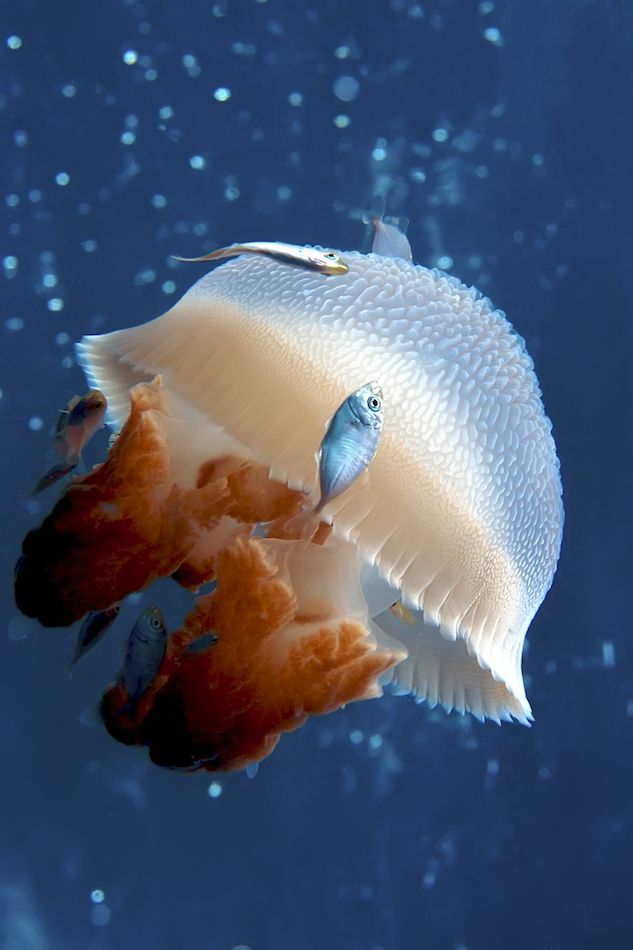
"The sea turned red from these jellyfish and there was nothing we could do about it, absolutely nothing," he said. And even earlier in the summer, visitors to beaches in Cornwall and Dorset were warned of the danger from poisonous jellyfish - the so-called "Portuguese warships".
The threat to bathers is also growing. Burns from some species of jellyfish found off the coast of Britain - such as "Lion's Mane" - can cause death. The project will enable a broad study of the impact of jellyfish on the Irish Sea ecosystem, he added.
Professor Hayes and his Irish colleague Professor Tom Doyle are going to attach special sensors - small devices that record information about the temperature of the water and its depth - to large cornerot jellyfish, which are now found off the coast of Britain and which in diameter can reach one meters.
After the death of an individual, it is hoped that these sensors will be washed ashore and they will be found. Experiments have shown that this kind of data collection works.